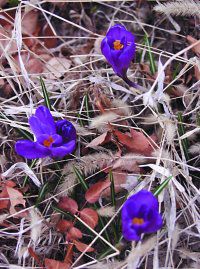| While lawns account for nearly one-half of the outside watering demands, landscapes also include thirsty flowers and plants. As Carbon County enters a fourth drought year, Price officials are stressing water conservation. |
Carbon County is entering into the fourth year of a substantial drought cycle due to continued below average snowpack and low spring runoffs.
Price Mayor Joe Piccolo recently requested all community members to voluntarily limit outside water usage until May 15. After May 15, the mayor asked businesses and residents to use only 50 percent of normal amounts through the watering season.
The voluntary effort, combined with an understanding of the rules for local water usage, may result in adequate conservation to avoid additional water usage restrictions, according to city officials.
Price city utilitizes an escalating scale for water rates. This means the rates increase based on the amount of water used.
Additionally, residents need to understand that non-culinary and processed water come from the same sources and should be conserved in a similar manner.
Ordinance 94-06 governs usage of culinary water by Price residents and entities. The guidelines set an outside watering schedule, regulating the amount used for irrigation of landscape and other purposes.
Restrictions are already in place regarding outside watering on Sundays, noted city officials. The action is necessary as the Price Canyon water treatment plant plans production around the schedule and shuts down on Sunday for maintenance. It typically takes until Wednesday for production to catch up with usage and refill the storage tanks.
In addition to the Sunday restriction, the outside usage schedule specifies:
•Price city will water only on Monday, Wednesday and Friday.
•Large water users like the school district, care centers, college, churches, housing developments, apartments and shopping centers may water only on Tuesday, Thursday and Saturday.
Large water users may experience watering schedule adjustments to facilitate special events.
Lawns are a primary concern during a drought. Grass accounts for nearly one-half of the water used around homes and businesses.
Most residents tend to water grass too frequently and leave the outdoor sprinklers on for too long.
Turf studies have shown that most lawns only need to be watered once every three or four days to remain healthy and green, pointed out Price city officials.
Watering every day creates a shallow root system in grass. Watering infrequently develops deep roots and healthier turf. Grass roots grow deeper into the soil and become stronger with less watering.
If a lawn does not spring back after being stepped on, it may be time to water.
Water lawns, plants and landscapes only when it is needed.
People should remember that grass may need more water when the temperature is hot or less in cooler weather. Water less when it rains. Avoid watering in windy conditions or at midday when the evaporation level is the highest. Try to water during the early morning hours.
Proper lawn and landscape watering can conserve a significant amount of the natural resource and that saves residents money as well.
City officials have developed several recommendations that not only Price citizens, but Carbon County residents can use as a guide for lawn watering. In general, people should water lawns every four days in the spring, every four days in the summer and every three days in the fall.
Several additional tips designed to help with water conservation include:
•Check the inside of residences for problems like running toilets and the outside of homes for water leaks.
Fix the leaks immediately. No matter how small a problem may be, the leaks will use large quantities of water.
•Avoid daytime lawn andlandscape watering.
Stick to the recommended schedule and only water in the mornings or evenings.
•Avoid overwatering grass and landscape plants.
Adjust or replace timers, valves and controls when necessary.
Timers may need routine adjustments to prevent water from running off the lawn.
•Install more efficient sprinklers or drip irrigation systems.
•Water in the center of areas of grass.
Applying moisture to center areas of the lawn will allow extra water to reach the edges and not flow over onto the streets, driveways or sidewalks.
•Plant low-water need plants in yards.
•Check yard sprinkler systems to ensure proper coverage regularly.
•Cut lawns higher and more frequently.
Grass clippings or mulch will hold moisture in planters.
•Avoid over fertilizing your yard.
•Spot water individual dry areas by hand.
Watering by hand allows people to avoid using the entire sprinkler system zone.
•Install and use nozzles that shut off on all outside watering hoses.
•Sweep driveways and sidewalks at residences as well as businesses with a broom rather than hosing off the areas with water.
•Avoid using excessive amounts of water when washing cars, boats, campers, etc.
•Only use household appliances when full.
Operate washing machines and dishwashers only after the appliances have full loads.
•Use aerators on all faucets.
Install water saving toilets, shower heads and fixtures.
•Dispose of kitchen wastes in garbage containers.
Refrain from using garbage disposals and sinks, which require water.
Dispose of bathroom litter in the trash, not by flushing down the toilet.
•Fill bathtubs only one-third or one-half full.
Take shorter showers.
•Insulate hot water heater and pipes.
By implementing the recommended conservation guidelines, Price and Carbon County residents may be able to avoid facing water restrictions that may be implemented in the coming weeks and months due to the drought conditions.
For additional information, Price citizens may contact the city offices at 637-5010. The city will provide conservation advise, a brochure and information regarding Price’s water conservation garden.
Carbon County residents may also contact the Utah Division of Water Resources for conservation tips and drought-related information.

